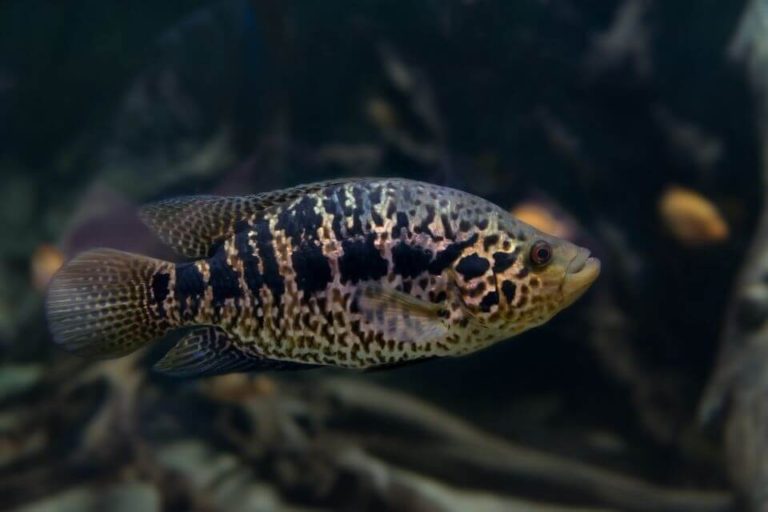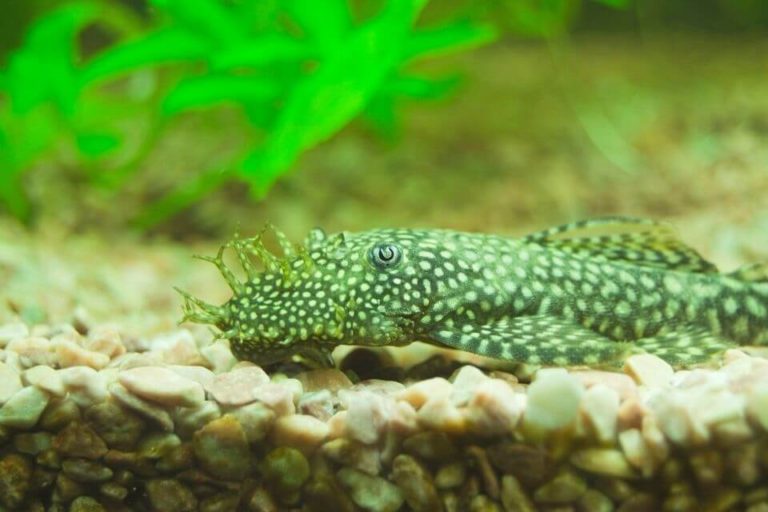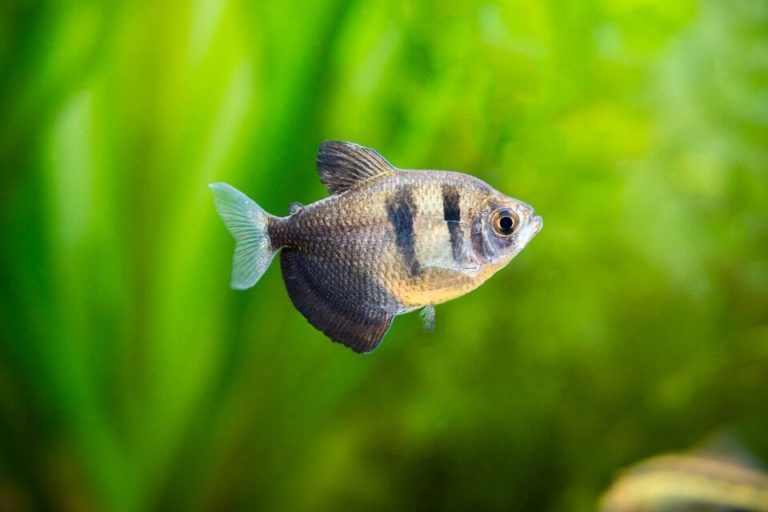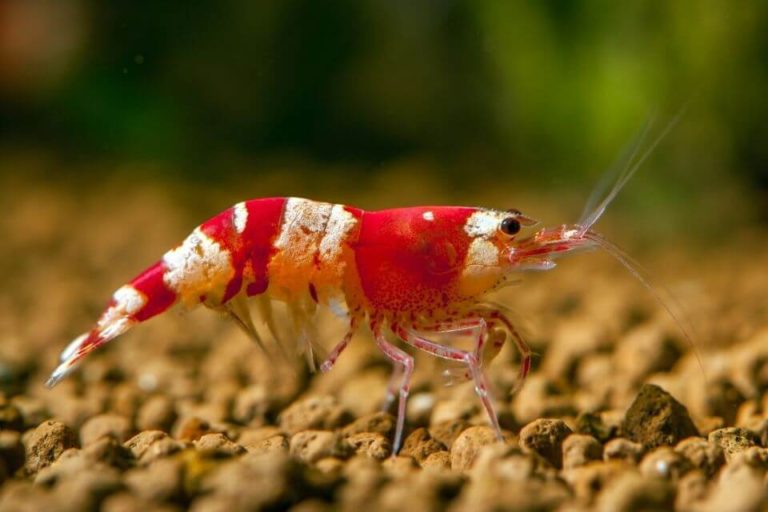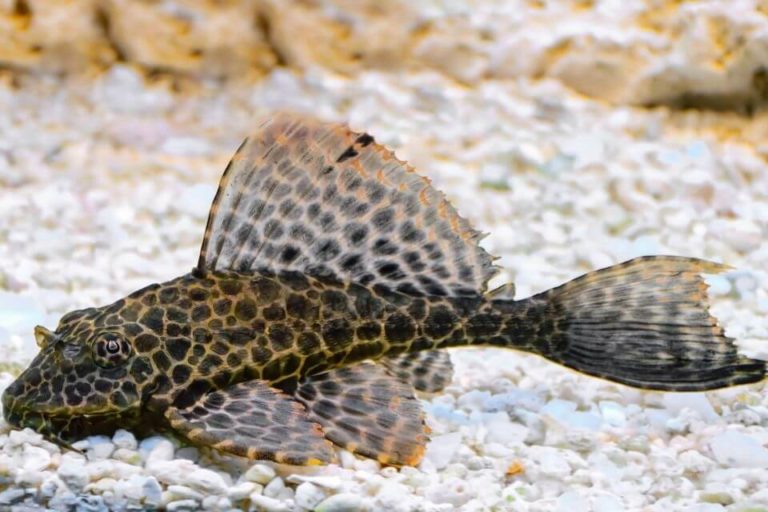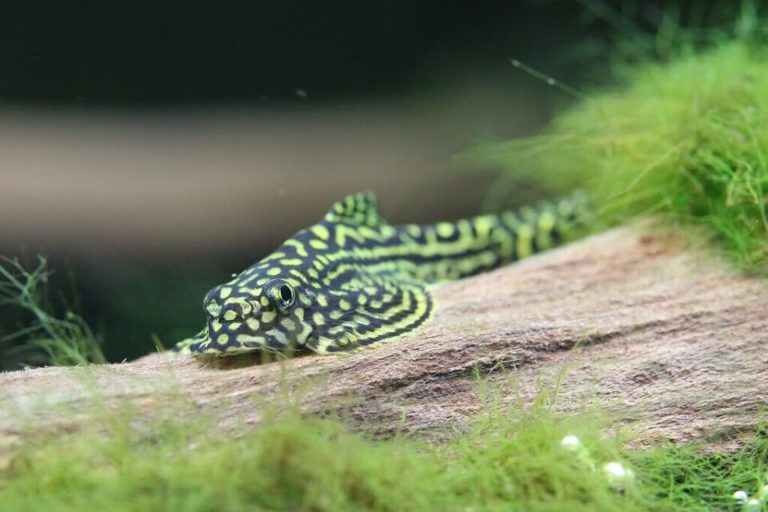Dinosaur Bichir Care (AKA Senegal Bichir) : Size, Lifespan and Tank Mates
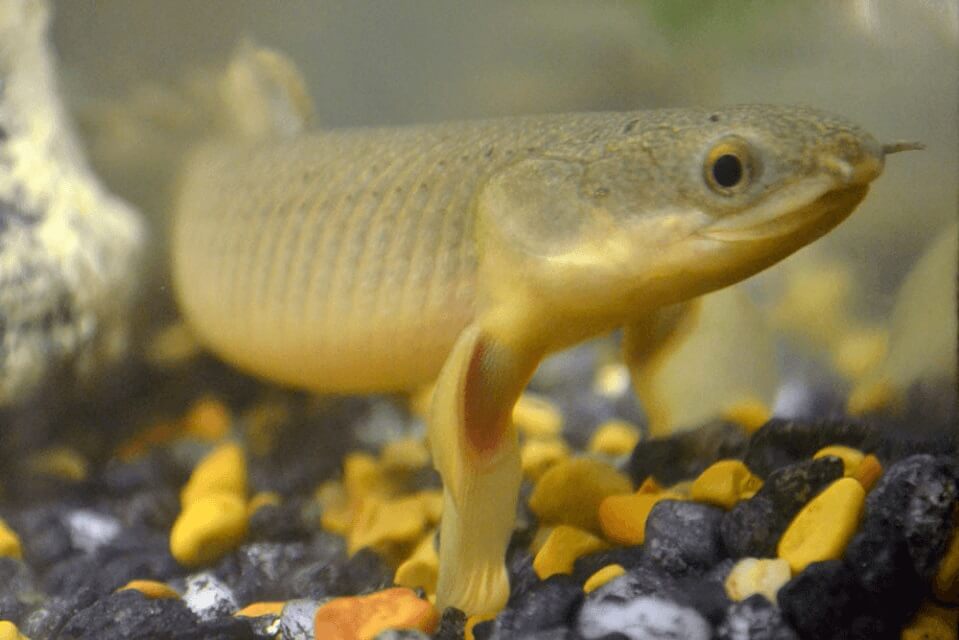
Dinosaur Bichir is a long-bodied freshwater fish species that spend most of their time at the bottom of the tank. Because of its appearance many aquarium fishkeepers love to keep them in home aquariums.
Therefore, if you want to know more about a Dinosaur Bichir fish (AKA Senegal Bichir) and what it looks like, you should keep reading this informative article.
This Dinosaur Bichir care guide will give you detailed information on this long freshwater fish.
Species Overview
The Dinosaur Bichir is presently known by several different names. Therefore, if you are doing your own research, you may search google for the names Reed Fish, Senegal Bichir, Swamp Dragon, or Dinosaur Eel.
These are just a few names that you can look for. However, there are also others that you may want to add to your list. The image of the Dinosaur Bichir makes it easy to recognize, however, whenever you see it.
This is because its odd appearance makes it very easy to identify, particularly when the image has the following characteristics.
- The long, thin body that looks like an eel
- Teeth that’s pronounced and protruding nostrils.
- Iridescent wide eyes
- The resemblance of a dragon
- serrated dorsal fin
This fish is also known for being a carnivore and will lie in wait to ambush their prey when they are unsuspecting.
Dinosaur Bichir Size
One of the questions that most people want to know is how big a full grown dinosaur bichir size is. Although this fish is considered to be one the tiniest within the Polypterus species, their potential for growth is quite lengthy.
For instance, some of the full grown Dinosaur Bichir size is approximately 20 inches long (50 cm). To make sure this fish is noted for the longer length, they do have the capability to lay on their back and extend their body fully, too.
Dinosaur Bichir Lifespan
The lifespan of a Dinosaur Bichir fish can vary greatly based on a number of different factors. One of the most essential is the conditions in which they reside.
Therefore, if you want a small dinosaur bichir to live a long healthy life, it is important that they always receive the appropriate care.
For instance, the lifespan of this animal usually lasts from about 10 to 15 years. This timing, however, is based on the condition and how they are actually treated. In some cases, the life span of this fish may even top out at 20 years.
Dinosaur Bichir Appearance And Colors
The dinosaur Bichr is a very interesting-looking fish. Its overall image can be described as vaguely cylindrical body shape, and it is quite long. When you see its colors, you will also say that there is a color blend that is mainly grey, beige and brown.

On the top of its body, you will see a wide range of colors that make up its scales. For instance, the colors of the scales are shades of blue, pink, and white.
You can often tell the differences between the male and female dinosaur bichir fish, specifically because the male counterpart is normally smaller than the female fish, and the size of its anal fin is distinct.
When you look at this fish’s eyes, you can easily see that they have black pupils and pale yellow eyes. Each of their eyes is located on the sides of the head.
The shape of the mount is quite large for a fish. However, when this fish closes its mouth, it has the appearance of a fish that is always grinning.
Other Types Of Bichir Fish
While the dinosaur bichir is one of the unique and interesting fish that you can research today, there are still others in this same species that you may want to know about, too.
Here are 4 of these species that make fascinating subjects when you want to learn the uniqueness of each and what they are best known for. So, let’s get started by describing the Delhezi Bichir.
– Delhezi Bichir (Aka Barred Bichir)
The Delhezi Bichir, aka Barred Bichir, is one of the most popular fish that many people enjoy seeing today. This is especially true for those people who are considered to be ornamental fish enthusiasts.
In fact, one of the primary reasons for such great popularity is its distinct black bar patterns. You can see these patterns on the top surface of its body.
And, some people may even call it by the name dinosaur eel, especially since this is what this fish really looks like.
– Ornate Bichir
Another popular fish that ornamental fish enthusiasts love seeing is the Ornate Bichir. This fish is one of their favorites because of its unique black and gold colors.
The adults can also grow to as long as about 24 inches. This fish is also known for having a slim Eel-like appearance. Though this fish can be described as mainly nocturnal is still considered to be very active during the day hours.
– Saddled Bichir
The Saddled Bichir has a long history since it has ancient origins. And, it is known for being a rare fish that can only be caught in the river between certain hours of the day.
Therefore, if you really want to catch this fish, you need to be at the fishing hole between the hours of 9 p.m. and 4 a.m. During specific months of the year (i.e., between June – September). The size of the fish is about 60 centimeters.
– Albino Bichir
When you see the Albino Bichir, you cannot help but notice some of its fascinating characteristics. Just like the name implies, the color of this is albino; it grows to the length from about 12 to 18 inches.
The length of this fish varies since it grows to 18 inches in the wild and only 12 inches in an aquarium. They are also known for eating the smaller fish but leaving, the larger fish undisturbed since they can only eat fish that fit into their small mouths.
Behavior & Temperament
Just like any other species of fish, the Bichir species is known for having a specific type of behavior and temperament. However, this species of fish tends to survive well in both wildlife rivers and aquarium settings.
These fish species are considered to be moderately aggressive when they live amongst other fish species. Typically, however, they can be a problem when they are placed in the water with the smaller fish.
For instance, if you place the bichir species in the aquarium with the smaller fish, they are more than likely going to be the aggressor.
When this happens, you can expect them to begin feeding on the fins of the little fish first. Or, when they choose to do so, they will swallow them alive.
On the flip side, if you place the Bichir in an aquarium with the larger fish, they tend to be more docile. Again, this is because they cannot eat the larger fish in their fish tank.
Also, the most aggressive fish of this species is considered to be the Ornate Bichir.
Dinosaur Bichir Care
If you decide to get a Senegal Bichir as a little friend for your aquarium, you need to make sure that you do a thorough job of preparing to care for them. Whether it is a male or a female, you need to know what is required of you.
This is especially the case for those of you who may be thinking about breeding them. Fortunately, however, this is a species of fish that really does not require a lot of care and maintenance.
Typically, you need to know what temperature is best for their survival. For instance, this fish thrives well in tropical temperatures. Therefore, you need to make sure the temperature of the waters stays around 75 to 85 degrees Fahrenheit.
– Dinosaur Bichir Tank Size
Before you decide to take this species of fish home, you need to know what types of tanks and sizes you need for proper care and maintenance.
In this case, some people say that it is a good rule of thumb to make sure that you have the optimum size for the gallons of water that is needed. For instance, the Dinosaur Bichir tank should contain about 75 gallons at the very minimum.
On the other hand, some people highly recommend a 100 gallons size tank for the Dinosaur Bichir’s tank. Buying a bigger tank would be practical because they will have a sufficient amount of room to grow.
Even though it is really not known how fast this fish grows, most fish owners usually say that you can expect about 2 to 3 inches within a month.
– Dinosaur Bichir Tank Setup
If you are new to the world of the Dinosaur Bichir, you need to learn as much as you can about the habit and conditions that are needed to keep it in a fish tank or aquarium.
In fact, the only way to make sure that you know exactly how to set up a tank for this species of fish is to understand the types of waters that they are used to.
Other things to consider are the size that they grow, the behavior (moderate or very aggressive with other fish), and anything else that will help you to make informed choices.
So, here are some of the key things that you should be aware of before you make your investment:
Substrate:
You need to know what the best substrate is for this species of fish. This is because a sandy substrate is actually needed for their environment. Since these fish are considered to be bottom feeders, the sand is better on their bodies instead of gravel.
Also, you do not want these bottom feeders to eat the gravel stones accidentally when they are scavenging around for other fish at the bottom of your aquarium.
Decorations:
It is relatively simple to decorate the tank of these fish. This is because their tanks can be quite sparse. For instance, you may only want to add some driftwood, plants, and some caves to keep them busy. This is a fish that is not really finicky about its habitat.
Aquarium Water Filter:
Though this fish does not require a lot of maintenance and care, you will need to make sure that you are changing out your filter regularly. One rule of thumb is to make partial water changes at least twice a month. You need to ensure the water has enough nutrients but not too much nutrient buildup.
Lighting:
You need to make sure that the tank has the appropriate lighting specifications for this species of fish. For instance, the lighting in the tank should be low-intensity to accommodate the types of plants that you will need to place inside of their water.
– Water Conditions And Parameters
As mentioned earlier, there are specific requirements needed in the tank for this type of fish. Since they are tropical fish, the temperatures should also simulate this environment. However, it is also important to note that this fish can also tolerate a significantly wide range of water conditions.
– Suitable Plants
The most suitable plants for this species of fish are the low light plants like the Java Moss, Anubis, and the Java Fern.
– Possible Diseases
Keeping the dinosaur bichir healthy is also a big part of taking care of these fish properly. Similar to most other fish in an aquarium, these fish can be susceptible to specific kinds of illnesses and diseases. For instance, one common disease that you should look out for in this fish is called the ich. The ich is a disease that can usually be traced back to problems in the tank with protozoa. Medications can be used to treat these diseases, and this species of fish usually responds well and quickly to this healing process.
Dinosaur Bichir Food And Feeding
The feeding habits of the dinosaur bichir are similar to other fish in the seas and rivers. In fact, like some fish, they are considered to be predatory fish. So, when you look up what this species of fish can do, you may be surprised to know that they like to nibble on the fins of small fish. Yet, they leave the large fish alone. Also, if the owner of these fish wants to give them a good meal, they may want to give them a frozen meaty treat.
- Pellets
- Tetra Blood Worms
- Freeze Dried Shrimp
- Freeze Dried Tubifex
- Mussels
- Live worms
- Flakes
Gender Differences
When you are observing this species of fish, you will find that there are some distinguishing features that are unique to each. One of the most notable is the difference between the male and female is the anal fin. For instance, when you are looking at the male dinosaur bichir’s anal fin, you can easily see that their anal fin is a lot broader than the female’s anal fin. For this reason, this is one of the designs of their body that helps to facilitate how they mate with each other.
Dinosaur Bichir Breeding
As mentioned above, their anal fins are designed specifically for the purposes of mating. And, this is why the male anal fin is broader than the female anal fin. So, this is also one of the ways that they can be bred with one another.
Here’s a little bit more information on how the dinosaur bichir is bred:
During a period of several days, the female Bichir will deposit hundreds of eggs (100 to 300 eggs). When she begins to deposit her eggs (several eggs each time), the male dinosaur bichir also begins to take their part. And that is to fertilize the eggs that have been deposited by the female. The actual fertilization process involves the following:
Male cupping his caudal fins and anal fins around the genital area of the female that he is mating with.
After which, the male dinosaur bichir will take the eggs from the female and complete the fertilization process with them.
When this part of the breeding process is complete, these eggs are then scattered over the surrounding plants in the water.
Dinosaur Bichir Tank Mates
When you are filling up your tank with different types of fish, you need to know which fish are considered to be compatible. For instance, if you are setting up a tank for the Dinosaur Bichir, you need to find out which fish, large and small, you can build their community with. These decisions are often made based on each species aggressiveness and other related factors.
Here are some fish species that make good Senegal Bichir tank mates:
- African Butterfly Fish
- Black Shark
- Hoplo Catfish
- Peacock Bass
- Oscar Fish
- Blind Cave Tetra
- Blue Acara
- Leopard Ctenophora
- Black Ghost Knife Fish
- Elephant Nose Fish
Origin And Distribution
The history of the dinosaur bichir dates back to prehistoric times. Just like the Dinosaur was on the earth 60 million ago, this fish is just as old and primitive.
This species of fish could be found in Africa, from the waters in West Africa to the Nile River basin.
Furthermore, this species of fish was considered to be quite unique, especially since it could be classified as a wild freshwater fish. Therefore, if you wanted to buy a Dinosaur Bichir as a pet for your freshwater fish tank, these fish species could only be found residing in the river margins, small to large lakes, floodplains, and swampland too.
Frequently Asked Questions
Are Dinosaur Bichirs Aggressive?
The behavior and temperament of the dinosaur Bichir can be quite problematic. So, it is very important that you understand their actions, particularly as it relates to their own survival. For instance, even though they are not looking to pick a fight with the larger fish, they are still considered to be predatory. In fact, this is one of the primary reasons why you cannot put this species of fish in a tank with the smaller fish.
For that reason, they are normally labeled as moderately aggressive in temperament. Typically, whenever you place the dinosaur bichirs in a tank with the little fishes, they are more prone to nip on their fins and will eventually eat them for food.
How Many Dinosaur Bichir Should Be Kept Together?
The answer to this question will vary since the size of the tank that you are using can differ from one person to another. For instance, if you have a large tank that can accommodate the needs of more than one Bichir, this can be a great ideal.
On the flip side, if the tank is not large enough, you may only keep one or two in your tank at a time. It is also important to note that you want them to get along well with others in the same species.
Is A Dinosaur Bichir Hardy?
The Dinosaur Bichir is also known for being a very hardy species in the fish world. Therefore, if you are preparing a fish tank or aquarium, you need to factor in these specifications and requirements. Typically, this species of fish requires a huge tank size (i.e., a minimum of 90 gallons (341 L) of water).
How Big Does A Dinosaur Bichir Get?
As referenced above, this species of fish can easily grow to between 11.8 and 23.6 inches. However, compared to some other members in the Bichir species, this size is usually in the high middle end. This is because the highest end in this same species is about 29 inches.
Can I Keep A Single Dinosaur Bichir?
The size of the tank is usually what dictates how many Dinosaur Bichir can be kept in your tank. So, if you want to keep a single fish, this is your choice. Based on the research on this issue, however, this is not really a common practice.
Is Dinosaur Bichir Bottom Feeders?
The Dinosaur is a bottom feeder in any environment that they are placed in, large rivers and large tanks. Normally, very peaceful in temperament. Yet, the little fish will need to always watch out, especially since the little fish at the bottom is being sensed as food.
Where Do You Get The Dinosaur Bichir For Sale?
Because the dinosaur bichir is considered to be rare, they are pets that are not easy to find at a reduced price or on sale. However, if you are looking for this type of pet in the US, you may want to check out PetSmart stores to see what they offer.
The price of a dinosaur bichir usually varies based on several different factors. The price is often based on the size, the location of the purchase, and any special handling fee involved. For instance, if you are shopping at PetSmart in the US, you may expect to pay around $75.00.
On the other hand, if you are buying a dinosaur in another country, you may be charged 4000 Bells in Japanese yen.
Final Thoughts
Since the dinosaur bichir has been around for millions of years, it has a long distinguished history. And is known for having an odd-looking cylindrical body shape that ornamental enthusiasts love.
So, if you want to keep this fish as a pet, you need to pay close attention to the care that you provide. This species of fish usually thrive well in a large aquarium among large fish.
However, because it is a bottom feeder, you should not add small fish to the tank that you prepare.


